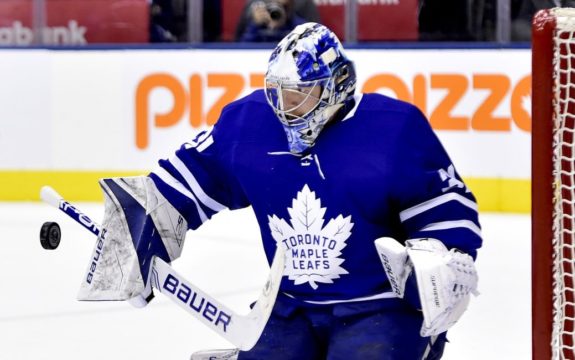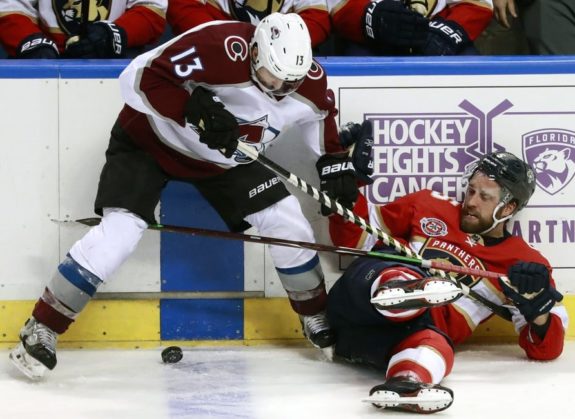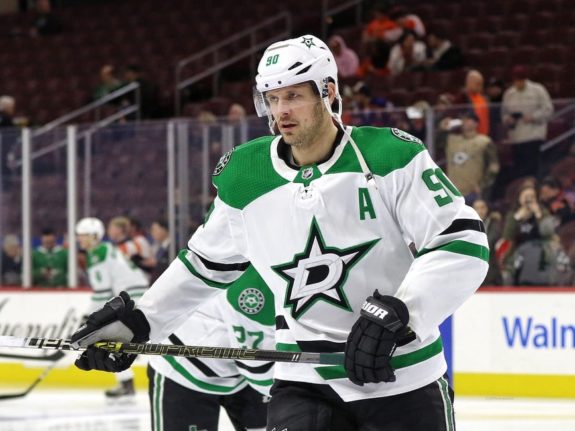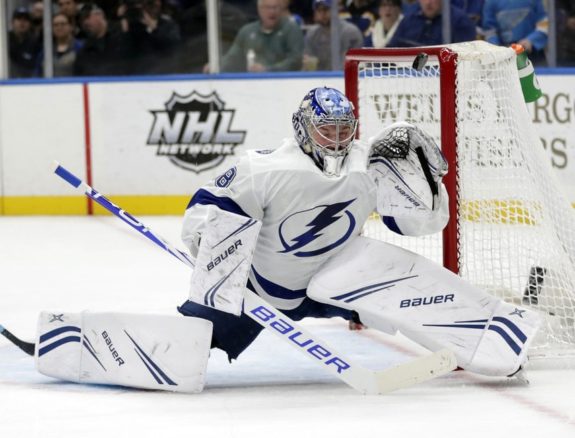If you follow the Toronto Maple Leafs, you are immensely aware that Frederik Andersen is one heck of a goaltender. Annually saddled with heavy workloads as a member of the the team behind some suspect Leafs’ blue lines in recent years, it’s been widely argued that Andersen has been their team MVP, even while young guns such as Auston Matthews and Mitch Marner burst onto the scene in recent seasons.
We’ve seen brilliant stretches from the big Dane in his Leafs tenure, and, of course, some rough ones, as well. However, given his skill set, the makeup of the club heading into the 2019-20 season and his past production, is this the season Andersen fully enters the Vezina conversation? I think it is, and I’ll tell you why.
Improved Blue Line
While the Maple Leafs own one of the most dynamic and dangerous groups of forwards the NHL has to offer, the chinks in their armor in recent seasons has clearly been on the blue line. The Leafs have ranked in the bottom 10 in shots against per game in each of Andersen’s three seasons with the club and in the bottom four in each of the first two campaigns. As a result, he has faced the most shots in the NHL over the last three seasons, and it’s not even close. Sure, he’s been a workhorse in the crease, starting at least 60 games in each of his three seasons with the club. These numbers would be higher, but he’s dealt with injuries, as well.

However, things could change this season behind a revamped Maple Leafs blue line. General manager Kyle Dubas addressed his team’s need for right-shot defensemen in the top four after left-shot veteran Ron Hainsey and the now-traded Nikita Zaitsev held down those positions over the last two seasons. Incoming is Tyson Barrie and Cody Ceci, a pair of right-shot defenders with notable NHL experience. Barrie is an advanced stats darling with a career 53.7 Corsi for percentage (CF%) and a 58.7 CF% mark from last season. He starts an overwhelming amount of his shifts in the offensive zone, but the fact remains that his team out-shoots the opponent when he’s on the ice.
Ceci’s advanced numbers are quite poor, but he’s also started 60.5% of his shifts in the defensive zone in his six-year NHL career to this point, the last two of which came on defensively-challenged Ottawa Senators teams that had zero transition game and spent an overwhelming amount of time in their own zone. The jury is out on whether Ceci’s game can rebound in Toronto. However, he’s going to get much more help from this forward group in exiting the defensive third than he’s had with the Senators of late. Besides, Zaitsev owned some poor advanced numbers over the last two seasons, making it hard to imagine the situation getting worse on the right side of the second pair.
Now, the makeup of the bottom pair is unclear at this point. Travis Dermott will be on the left side of that pairing eventually, but the timetable for his May 10 shoulder surgery puts him out of action for roughly the first month of the season. The Maple Leafs traded prospective bottom-pair youngster Calle Rosen in the deal to acquire Barrie, so we could very well see rookies Rasmus Sandin and Timothy Liljegren enter the mix alongside AHL regulars Justin Holl and Martin Marincin at training camp. While the bottom-pair situation may not benefit Andersen to start, Dermott and his career 52.9 CF% will return and the club’s top four is largely improved from last season’s group.
Center Ice Help
The key to team defense in this sport not only lies on the blue line and in the crease, but up front, as well. This is an area where the Maple Leafs improved this offseason with the additions of Alexander Kerfoot and Jason Spezza.

Kerfoot, in his second season in the NHL, posted a 56.3 CF% last season in all situations and a face-off winning percentage of 56%, both of which are outstanding figures. In layman’s terms, the Avalanche outshot their opponents 1218 to 947 with Kerfoot on the ice. Even in his rookie season, he posted a 54.7 CF% while his club outshot their opponent 1069 to 884 with him on the ice. Kerfoot is widely expected to take Nazem Kadri’s spot as the third-line center, providing Andersen with an asset that spends more time in the offensive end than in his own end. For what it’s worth, Kadri boasted very good advanced metrics and face-off numbers last year. However, Kadri’s face-off numbers were poor until this past season and Kerfoot’s footspeed outweighs that of the Leafs’ former third-line pivot in terms of exiting the defensive end.
The biggest difference here could come further down the center ice depth chart with the addition of Spezza. Spezza is an advanced metrics beast, producing a career 58.4 CF% and posted a 57.3 mark last season despite scoring just eight goals and 27 points. Yes, he’s started more than 63% of his shifts in the offensive zone in his career, but those are monster figures, nonetheless.
Furthermore, Spezza absolutely cleaned up in the face-off dot last season with a 58.2% winning percentage. Of players who took at least 800 faceoffs last season, that winning percentage tied New Jersey Devils center Travis Zajac for the best in the league. Spezza owns a 53.8% faceoff winning percentage for his career, but has exceeded that mark in six of the last seven seasons. I would expect Spezza to begin many more shifts in the defensive zone with his new club given those numbers.

While Frederik Gauthier — last year’s fourth-line center — did well in the face-off dot with a 53.7% mark last season, he also posted a 45.1 CF% and owns a 42.4 mark for his career. Like most fourth-line centers, those numbers come with a heavy dose of defensive zone starts. However, it’s not difficult to see from Spezza’s numbers that he will be an upgrade in terms of taking important defensive zone draws and using his still-above-average vision to help the Maple Leafs exit the defensive zone at a better rate than Gauthier has accomplished in his brief NHL career.
Keep in mind what the Maple Leafs already had in tow down the middle. John Tavares and Auston Matthews are both easily positive possession players for their careers while they both sit above the 50% mark in terms of face-off winning percentage as well. As a result, the Maple Leafs now have four centers who control possession on the ice while winning the face-off dot battle to boot. That, in turn, takes the load off of the overworked Andersen in goal.
Andersen by the Numbers
And then there’s Andersen himself. Behind some stout Anaheim Ducks defenses prior to being dealt to Toronto ahead of the 2016-17 campaign, Andersen never posted a goals against average (GAA) over 2.38 or a save percentage (SV%) under .914. The GAA has slipped behind a softer Maple Leafs blue line, but his SV% figures have been remarkably consistent with marks of .918, .918 and .917 in his three-year Leafs tenure.
Of 22 goaltenders who have faced at least 4,000 shots over the last three seasons, Andersen’s .918 SV% ranks seventh. The names above him? John Gibson, Sergei Bobrovsky, Pekka Rinne, Andrei Vasilevskiy, Robin Lehner and Devan Dubnyk. Vasilevskiy, Rinne and Bobrovsky are winners of the last three Vezina Trophies while Lehner was a finalist just last season. All of the names above Andersen have received Vezina votes in the past.

In Vasilevskiy’s case, his .921 SV% over the last three seasons is only narrowly higher than Andersen’s .918 mark in that same span, yet he won the Vezina last season and finished as the runner-up in 2017-18. He’s definitely benefited from a stronger defensive group in front of him, as have all of the goaltenders above Andersen on this list. It can certainly be argued that no goaltender has done more with less than Andersen since he pulled on a Maple Leafs uniform. Given his three consecutive 60-start seasons, he’s also managed to rank third in wins over the last three seasons, and we know how important wins are in the Vezina vote.
Given his position among the game’s best goaltenders despite playing behind the worst defensive team of them all, it’s more than reasonable to assume Andersen can put forth a Vezina-worthy season if the defense improves in front of him and the Maple Leafs’ new-look group of centers can do their part in easing the burden he’s been shouldering as a Maple Leaf. If these items fall into place for the 29-year-old Dane, we could certainly be talking about the 2019-20 Vezina Trophy winner.